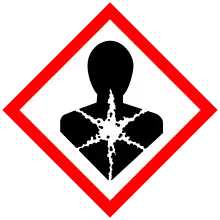_oxalate.svg.png.webp) | |
| Identifiers | |
|---|---|
3D model (JSmol) |
|
| ChemSpider | |
| ECHA InfoCard | 100.011.284 |
| EC Number |
|
PubChem CID |
|
| UNII | |
| UN number | 2291 |
CompTox Dashboard (EPA) |
|
| |
| |
| Properties | |
| PbC2O4 | |
| Molar mass | 295.219 |
| Appearance | White Powder |
| Density | 5.28 g/cm3 |
| Melting point | 327.4 °C (621.3 °F; 600.5 K) |
| Boiling point | 1,740 °C (3,160 °F; 2,010 K) |
| 0.0091 g/100 ml (25 °C) | |
| Thermochemistry | |
Std molar entropy (S⦵298) |
146.0216 J [1] |
Std enthalpy of formation (ΔfH⦵298) |
-851.444 kJ/mol |
| Hazards | |
| Occupational safety and health (OHS/OSH): | |
Main hazards |
Nephrotoxin, Reproductive Toxin, Neurotoxin, IARC Carcinogen, Birth Defects, Highly Toxic |
| GHS labelling: | |
   | |
| Danger | |
| H302, H332, H360, H373, H410 | |
| P201, P202, P260, P261, P264, P270, P271, P273, P281, P301+P312, P304+P312, P304+P340, P308+P313, P312, P314, P330, P391, P405, P501 | |
| NIOSH (US health exposure limits): | |
PEL (Permissible) |
0.05 mg/m3, as Pb |
Except where otherwise noted, data are given for materials in their standard state (at 25 °C [77 °F], 100 kPa).
Infobox references | |
Lead(II) oxalate is an organic compound with the formula PbC2O4. It is naturally found as a heavy white solid.[2]
Preparation
This compound is commercially available. It may be prepared by the metathesis reaction between lead(II) nitrate and sodium oxalate:[3]
- Pb2+(aq) + C2O42− → PbC2O4 (s)
Solubility
Lead(II) oxalate is insoluble in water. Its solubility is increased in presence of excess oxalate anions, due to the formation of the Pb(C2O4)22− complex ion.[4]
References
- ↑ "Lead(II) Oxalate". Chemistry Reference. http://www.chemistry-reference.com/q_compounds.asp?CAS=814-93-7.
- ↑ "Lead Oxalate". American Elements: The World's Manufacturer of Engineered & Advanced Materials http://www.americanelements.com/pboxl.html.
- ↑ Grases, F.; Ruiz, J.; Costa-Bauzá, A. (1993). "Studies on Lead Oxalate Crystalline Growth". Journal of Colloid and Interface Science. 155 (2): 265–270. doi:10.1006/jcis.1993.1035.
- ↑ Kolthoff, I.M.; Perlich, R. W.; Weiblen, D. (1942). "The Solubility of lead Sulfate and of Lead Oxalate in Various Media". Journal of Physical Chemistry. 46 (5): 561. doi:10.1021/j150419a004.
This article is issued from Wikipedia. The text is licensed under Creative Commons - Attribution - Sharealike. Additional terms may apply for the media files.